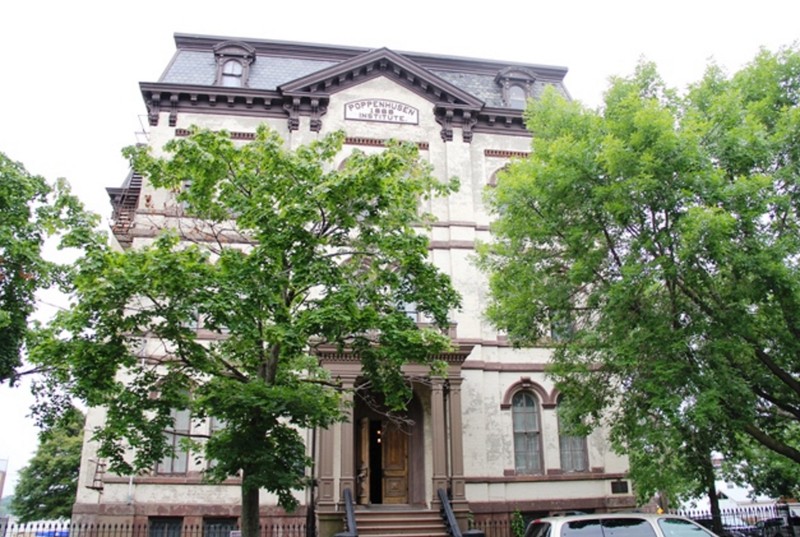Poppenhusen Institute
Introduction
Text-to-speech Audio
When it comes to community establishments in New York City, few come close to the rich history of the Poppenhusen Institute. Poppenhusen Institute is a historic building constructed in 1868. The building was designed to be an educational institution for adults entering the manufacturing industry, but later, it was used for a multitude of purposes that fit the needs of its community. The Institute is most famous for housing the first tuition-free kindergarten in America, which was open to everyone regardless of the individual's race or religion. Now, the building serves to display the rich history of Queens and her surrounding boroughs. The Institute holds several annual events such as the annual Oktoberfest Festival among many others. Due to its history and impressive architecture, the Institute was designated a New York City Landmark in 1970.
Images
Poppenhusen Institute

Backstory and Context
Text-to-speech Audio
The Poppenhusen Institute was constructed in 1868, largely funded by Conrad Poppenhusen, a German philanthropist. Poppenhusen became the benefactor of College Point when he paid a grand sum of $100,000 to commission the founding of a community in the area, including the Institute. The Institute stood five stories tall and was designed with the Victorian style of architecture in mind. All thanks to Poppenhusen's efforts, the institute became extremely successful in the College Point region.
Initially, the Institute was established for an indefinite number of reasons. Poppenhusen's optimal goal was for the Institute to serve as a place for vocational training and educational opportunities for industrial laborers. Over time, the Institute became increasingly popular and specifically helped out incoming immigrant workers by offering English classes. These English courses were later supplemented with French and Spanish classes. Eventually, more sophisticated leveled classes taught draftsmanship and machinery-job techniques for factory workers dealing with relatively complicated technology. The Institute was open for anyone (regardless of race or religion) looking to improve their lives by preparing themselves for better jobs. Many of those that attended became successful business owners in the area.
Eventually, Poppenhusen Institute's purpose changed to better suit the community. At one point, the Institute was a courtroom, while other times, it housed the German Singing Societies, Justice of the Peace, College Points Savings Bank, a library, and a Sheriff's Office. Instead of donating the artifacts from this time frame, the Institute held onto even the smallest of objects and safeguarded them into the attic. These relics included books, pictures, statues, and other historical collections dealing with means of education or instruction. The Institute still holds signs of its historical purposes, such as the two jail cells from the Sheriff's Office.
Because of its rich history and Victorian architecture, Poppenhusen Institute was designated as a New York City Landmark in 1970, but despite these designations, it was threatened with foreclosure and demolition. Fortunately, the zealous efforts of an ardent community group prevented the Institute's demolition. However, the Institute lost its state-sponsored financial backing and is now depending on donation-based funding to operate.
Initially, the Institute was established for an indefinite number of reasons. Poppenhusen's optimal goal was for the Institute to serve as a place for vocational training and educational opportunities for industrial laborers. Over time, the Institute became increasingly popular and specifically helped out incoming immigrant workers by offering English classes. These English courses were later supplemented with French and Spanish classes. Eventually, more sophisticated leveled classes taught draftsmanship and machinery-job techniques for factory workers dealing with relatively complicated technology. The Institute was open for anyone (regardless of race or religion) looking to improve their lives by preparing themselves for better jobs. Many of those that attended became successful business owners in the area.
Eventually, Poppenhusen Institute's purpose changed to better suit the community. At one point, the Institute was a courtroom, while other times, it housed the German Singing Societies, Justice of the Peace, College Points Savings Bank, a library, and a Sheriff's Office. Instead of donating the artifacts from this time frame, the Institute held onto even the smallest of objects and safeguarded them into the attic. These relics included books, pictures, statues, and other historical collections dealing with means of education or instruction. The Institute still holds signs of its historical purposes, such as the two jail cells from the Sheriff's Office.
Because of its rich history and Victorian architecture, Poppenhusen Institute was designated as a New York City Landmark in 1970, but despite these designations, it was threatened with foreclosure and demolition. Fortunately, the zealous efforts of an ardent community group prevented the Institute's demolition. However, the Institute lost its state-sponsored financial backing and is now depending on donation-based funding to operate.
Sources
Marvilli, Joe. "Poppenhusen Institute: A City Landmark Serving The Borough." Queens Tribune. 3/27/14. Accessed Web, 6/24/17. http://queenstribune.com/poppenhusen-institute-a-city-landmark-serving-the-borough/.
"History." The Poppenhusen Institute. Accessed Web, 6/24/17. http://poppenhuseninstitute.org/history/.
"Poppenhusen Institute." Forgotten New York. 6/13/12. Accessed Web, 6/24/17. http://forgotten-ny.com/2012/06/poppenhusen-instutute/.
"History." The Poppenhusen Institute. Accessed Web, 6/24/17. http://poppenhuseninstitute.org/history/.
"Poppenhusen Institute." Forgotten New York. 6/13/12. Accessed Web, 6/24/17. http://forgotten-ny.com/2012/06/poppenhusen-instutute/.
